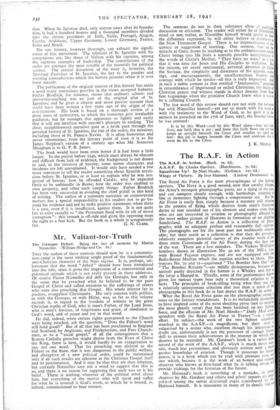The R.A.F. in Action
Wings of Victory. By Ivor Halstead. (Lindsay Drummond. 65.) THE Royal Air Force is the most phologinique of the fighting services. The Navy is a good second, now that cavalry charger, the Army's strongest photographic point, are a thing of the past, and can compete closely enough, with battleships steaming in line or destroyers fighting through a tempestuous sea. But the Air Force is easily first, simply because a mystery still attaches to the process of flying which derives from man's frustrated desire to soar unaided out of his element and makes even than who are not interested in aviation or photography affected by the most sedate picture of Harrows in formation or an alighting Sunderland. The R.A.F. in Action is a collection of photo- graphs, with an adequate preface and reasonably full caprices The photographs are for the most part not technically remark- able; but their merit as a collection is that they do provide I relatively complete pictorial survey of the routine work of the three main Commands of the Air Force during the first year of the war. There are a few mistakes. The Vickers Wellingteo bombers shown in illustration No. 5o are of the MK.i. type, with Bristol Pegasus engines, and are not equipped with the Rolls-Royce Merlins which the caption ascribes to them. Illus- trations No. 70 and 7r—captioned " The Bomber Sets Out" and " The Bomber Returns "—are mildly disingenuous, because the aircraft partly depicted in the former is a Whitley and that in the latter a Hampdin. Thirdly, some of the performance figure given for various types bear only a theoretical relation to the facts. The principles of book-titling being what they are, it it a relatively unimportant criticism that less than a tenth of the photographs in this book do in fact depict the R.A.F. in action. What the Royal Air Force gains on the photographic swings it loses on the literary roundabouts. It is its melancholy distinctire to have inspired some of the most shocking prose (not to mentico the most ghastly verse) that has been lavished on any fight doubt are, unfortunately is not the possessor of enough literal
corm
force, and the effusion of Mr. Noel Monks—" Daily Mail spondent with the Royal Air Force in France "—is a Mica! effort. Its subject—the work of the two 'fighter squadrons attached to the A.A.S.F.—is magnificent, but their story is vulgarised by a writer who, excellent though his intentions re
skill to present their achievements in the manner in which the,' deserve to be recorded. Mr. Gardner's book is a rather fuller record of the work of the A.A.S.F., which is much more gal' rate, much less pretentious, and obviously written with 3 11114 greater knowledge of aviation. Though it possesses no literal, graces, it is a book which can be read with pleasure now, Ina one which, because it is the work of an honest and accurge observer who knows at first-hand what he is talking about, provide pickings for the historian of the future.
Mr. Halstead's book is something of a pastiche, in chapters by Mr. Gardner and others and pilots' reports are iota' polated among the rather disjointed pages contributed by Mr' Halstead himself. It is inaccurate in many of its details and date in some of its facts, and the prose is liberally patched 'is purple Much of the book covers the ground already versed by Mr. Gardner and Mr. Monks, but the story is taken p to a somewhat later point in Air Force history. Like Mr. onk,' book, it was obviously written with the best of intentions; ut its value, because it appears to have been written almost tirely at second-hand, is even more problematical. DEREK- VERSCHOYLE.



























 Previous page
Previous page